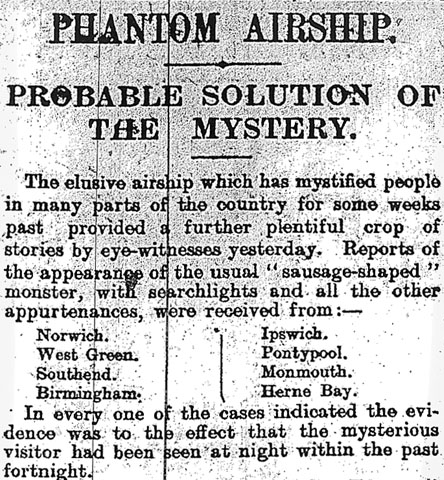On page 9 of the London Standard today is a short article entitled ‘ELUSIVE AIRSHIP’. Evidently the story is not quite new, for it begins:
The mystery of the elusive airship still continues to attract attention, and the belief is gaining ground that there is some foundation to the various reports. Obviously something has been seen and heard at night in the sky, usually at places in East Anglia, Clacton, Southend, Peterborough, Lincoln, Ipswich, to quote only a few instances.
But this is the first time that the Standard has made mention of this mystery (at least in May), so the writer appears to assume that the reader will be aware of the story from other newspapers. There is a new sighting (or rather hearing) to report, however, at Windsor made by Patrick Alexander, ‘the well-known expert on aeronautics, who is not likely to make a mistake’. One night recently — the date is not given — he ‘heard at night sounds apparently of an airship in motion’. Alexander thought it was the Army airship but this is not thought capable of such a ‘bold exploit’. Which is probably true: Baby, the only airship possessed by the government at this time, was not a very robust craft and was not flown much until rebuilt as Beta in 1910. The Standard has another idea:
One “explanation” is that some one owns an airship, and is trying it at night. It is known that there are one or two under secret construction in the country, but the difficulty is, given the relatively short period of darkness, to see how it avoids being detected in the early dawn.
This is not implausible. 1909 was at the dawn of the air age, and many people were trying to build aeroplanes and airships. One of the most successful of the latter were the Willows airships, designed and built by E. T. Willows of Cardiff. He was between airships at this time, however: Willows No. 2 was not to fly until November, and besides Wales is a long way from East Anglia. But who knows, maybe some hardy inventor was testing their contraption over Windsor a few nights ago.
That’s the only phantom airship story in today’s papers, or rather in the sample of papers I’ve examined. Although it’s only a small article, it is on page 9, in the middle of the paper, which more or less took the place the front page in today’s newspapers. So it’s not unimportant, either.
What else is going on today? Just below the ‘elusive airship’ story is another brief article reporting that the Wright brothers have sold 14 of their aeroplanes (first publicly demonstrated in 1908) in Europe: 10 in France, 2 to Austria, 1 to Germany and 1 to Britain. But the Standard is clearly more interested in the lengthy report of its special correspondent in Germany, who has toured shipyards in an effort to ascertain just how many dreadnoughts are under construction there (nine, it looks like). This, of course, is an echo of the great dreadnought panic which took place in March, when there was a violent political and press frenzy over claims that Germany was accelerating its naval construction and so might, conceivably, overtake the Royal Navy at some point. This then raised the prospect of a German invasion of Britain — or at least it did for Conservative papers like the Standard.
Other newspapers — again, at least the Conservative ones — have a similar mix of reports on defence and aviation issues. The London Globe, for example, has articles on the global naval balance (Britain has 53 battleships to Germany’s 32), a successful flight by the (singular) Army aeroplane (it flew as far as 1200 feet in one hop, reaching a height of 50 feet), the upcoming Frankfurt aeronautic exhibition (where various German cities will offer prizes to encourage progress), and a statement by Wilbur Wright on the future of aviation (of little use for military purposes at the moment). There’s clearly already a discourse going on about the role aircraft will play in war. But so far, however, the ‘elusive airship’ is not being framed as any sort of threat to the nation; it’s merely a curiosity.
![]() This work is licensed under a Creative Commons Attribution-NonCommercial-NoDerivatives 4.0 International License.
Permissions beyond the scope of this license may be available at http://airminded.org/copyright/.
This work is licensed under a Creative Commons Attribution-NonCommercial-NoDerivatives 4.0 International License.
Permissions beyond the scope of this license may be available at http://airminded.org/copyright/.




I started reading _Robur the Conqueror_ once as a young tyke. The bit about the American and a Canadian having a duel at Niagara Falls over whether the mystery airship was playing the American or British anthems was one of the foundations of my historical consciousness. (That and the appendices at the end of _Return of the King_.)
The rest was too boring, and I gave up.
When did Wells’ _The War in the Air_ come out in paperback? Was it serialised anywhere?
Not sure about paperback — not that there were many paperback editions published back then. Wells wrote it in 1907, and it was serialised in Pall Mall Magazine from January 1908. Good timing!
Pingback: Airminded · Post-blogging the 1909 scareships: thoughts and conclusions